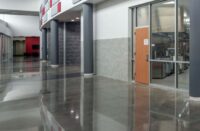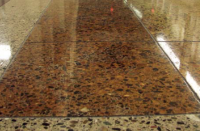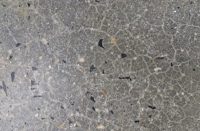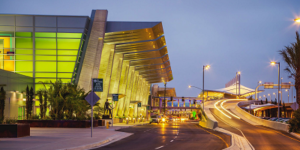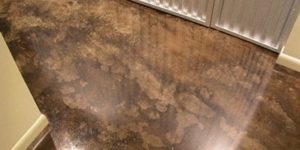As business owners, as soon as we open our eyes each day, we begin to think and search. Where are we going to find more work for our crews? Besides the usual options of bidding on new construction projects, refurbishing old polish jobs or removing epoxy coatings, there must be other ways to make money with our equipment and skills.
Let’s discuss two new markets for your crews to explore: cementitious terrazzo restoration and surface preparation for floor coverings.
Better terrazzo through polishing
Recently, I was speaking with the head of building maintenance at a university with more than 3 million square feet of cementitious terrazzo, and he had the following complaints about his existing floors:
- The floors are high-maintenance in terms of labor, time and cost.
- They are dull and hazy-looking due to wax buildup.
- Waxing and stripping is not a “green” way of maintaining a building.
The idea of maintaining cementitious terrazzo using polished concrete techniques is music to his ears.
Concerns about polished concrete seem to be centered on the slip coefficient and life-cycle cost. A “natural” polished floor (with no wax required) looks clear and shiny, and everyone knows that shine equals slip, right? This misconception can be handled by installing a mock-up and measuring the dynamic coefficient of friction (DCOF) on a polished floor, showing that it offers more resistance than their existing waxed cementitious terrazzo floor. Let them prove the numbers to themselves.
The other big question is whether our initial “grind, densify, and polish (with stain protection)” will be cost-effective. We must explain how they will reduce their life-cycle costs by polishing their cementitious terrazzo:
- They’ll have no further need to purchase products to wax and strip their floors.
- They’ll no longer pay for labor to perform tedious stripping and waxing.
- They’ll enjoy reduced maintenance costs due to faster daily upkeep.
The overall outcome will be better-looking, higher-performing, lower-cost floors.
The main composition difference between concrete and cementitious terrazzo is the cement-to-aggregate ratio.
Cementitious terrazzo is at least 70 percent marble-chip material and 30 percent cement matrix (with a portland cement binder). This is essentially the opposite of concrete, which is typically 70 percent cement (including fly ash or slag) and 30 percent aggregate (sand, rock).
When placed, cementitious terrazzo, is poured and troweled about 1/2-inch thick over a low-strength cement bed. It is then ground flat, honed, and sealed with a penetrating solvent-based sealer.
Cementitious terrazzo must be waxed to achieve the shine that the owner is expecting. We produce the shine with our diamonds, not through an applied wax finish. Also, we use densifiers to make floors harder and more abrasion-resistant, while terrazzo installers do not.
Will it feel different to grind and polish cementitious terrazzo? The main difference when working on cementitious terrazzo is that it is like grinding and polishing an exposed aggregate floor, not a sand or cream finish. Once that difference is understood, and you start with the right diamond grit, the grinding, honing, densification, polishing and stain-protection application will be similar to a polished concrete job.
Think about how many colleges and universities are located within your geographic business area – many have cementitious terrazzo floors somewhere on campus. Cementitious terrazzo is also used in public schools, churches and municipal and government buildings. When those floors are polished, the owners will see that the surface looks flatter, the curls and lippage are leveled, the uneven or high divider strips are gone, the floor no longer requires stripping and waxing, and the natural beauty and color have returned. They will become your advocates and another significant source of revenue.
Help for covering and coating installers
Our second new focus includes the floor-covering (and floor-coating) industries. They are the ones that normally take your business away, so why not take back at least part of it? Instead of competing with them, join their team.
There are three distinct services you can potentially offer to floor-covering contractors: surface preparation, calcium chloride moisture vapor testing and moisture-control coating installation. Diamond grinding plays a role in all three areas.
Every floor requires surface preparation prior to the installation of floor coverings. You’d be amazed at their surface prep approach – using cleaner-degreasers, acids, strippers and adhesive removers that must be applied, scrubbed, scraped, rinsed and neutralized, or using a buffer with sandpaper on the bottom. We know that the secret to achieving clean, absorbent concrete is to grind the floor using our diamond grinders! Your concrete grinder with a set of 40-grit metal-bond diamonds can offer the absolute best surface preparation at a truly competitive price.
Diamond grinding also helps dry out the floor. The heat from grinding will pull out moisture, and opening the concrete pores will allow excess moisture to escape. A floor-covering installer’s idea of hitting the jackpot is finding out this secret. In addition, tell them that your diamond grinder is a cost-effective method for removing a thin layer of concrete to erase all of the construction marks, flatten the floor, and reveal a fresh, clean, water-absorbent surface.
Most floor-covering installers have not made a capital investment in grinding equipment, so surface preparation slows them down. It is the variable that will either make or break their profitability. Flooring installers understand that flatter floors are better floors that require less leveling, fitting and cutting, which means the end results will look better, with less effort during the installation. Give them a per-square-foot cost that they can simply plug in for each job so they no longer have to worry about the floor-prep cost variable, just the installation.
Another service you can offer is the installation of moisture control coatings. You understand that concrete has more moisture concentration when new. Moisture vapor levels may also be high where there are issues with poor drainage or pipe damage under the slab. With older slabs, often either no vapor barrier exists at all or the vapor barrier may have been punctured or torn during placement of the concrete. Over time, the moisture will evaporate from the slab into the air. This vapor drive is harmless to polished concrete, but floor coverings and flooring adhesives will develop problems because of trapped moisture. When modern floor coverings (such as carpet tiles, solid-sheet vinyl, rubber floors and engineered wood laminates) trap the moisture, moisture attacks the adhesives and the floor covering may blister or warp. As a result, current floor coverings require the slab to meet limits on moisture vapor emissions. The remedy is to apply a moisture mitigation coating to the concrete to effectively slow down the moisture vapor emission rate.
Moisture control coatings must be applied to concrete that is clean, dry and water-absorbent. You can offer to install the moisture control coating once you have ground and prepared the floor – in most cases, it is like rolling an epoxy on the floor. The next day the floor coverings will be installed, and there will be one less floor that a picky owner might call you about. This is a nice contrast to the constant accountability you experience with a decorative polished concrete floor.
Third, you can prep for and even conduct ASTM-standard calcium chloride moisture vapor tests for flooring companies. These tests are inexpensive, simple to learn and easy to conduct. Better yet, surface grinding must be performed before the testing can be conducted.
These new income opportunities – restoration of cementitious terrazzo and surface preparation and moisture control for other installers – can be the answer to that nagging concern about finding more work for your crews.
